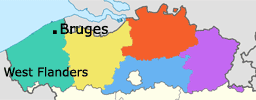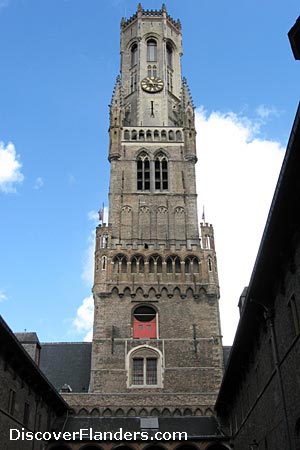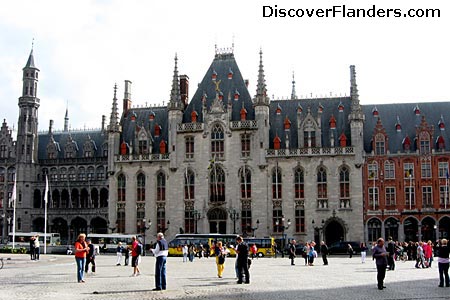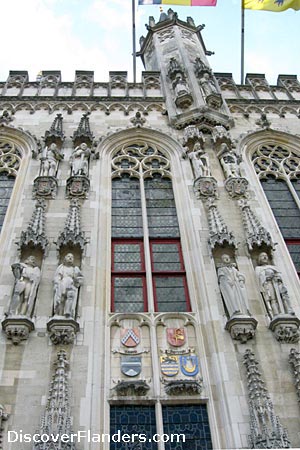|
Market Square of Bruges
 The most striking building on the market square of Bruges is undoubtedly the imposing belfry. The most striking building on the market square of Bruges is undoubtedly the imposing belfry.
In the later middle ages, the belfry of a city stood as a symbol of freedom and wealth. The belfry of Bruges was built and expanded from the 13th till the 15th century. The octogonal highest part of the tower houses the carillon since the 15th century. You can climb up to visit and get the splendid view over Bruges from the tower of the belfry. The carillon, which indicates the time every fifteen minutes from 7 A.M. till 9 P.M., is 'powered' from a machine room, where a copper drum (weighing 9,000 kg) is used as some kind of heavy software device on which the the carillon's melodies are written.
.jpg) |
Market Square in Bruges
Visit picture gallery of Market Square, and the Belfry |
|
 |
| Belfry of Bruges, as viewed from the courtyard. |
|
Facing the belfry, the left part of the market square is mostly occupied by the Provincial Palace. This neo-gothic building now is the residence of the governor of West Flanders. It is not an old building, dating just form the end of the 19th century. In the middle of the market square stands a statue of Jan Breydel and Pieter de Coninck, historical figures from Flanders' past.
 |
| Provincial Court on Market Square of Bruges. |
|
Midway, on the right side of the square we can see the Cranenburg House, where emperor Maximilian of Austria was incarcerated in 1488 (just to indicate how old the now restored building is).
Castle Square of Bruges
Adjacent to Market Square is Castle Square (or Burg), which was the former location of the first count's castle, built to defend against the invasions of the Vikings. As such it was the military, administrative and judicial center of Bruges and played an important role during many centuries. The St. Donaas cathedral formed the religious part of Castle Square, until it was demolished in 1800 under French occupation. A Holiday Inn Crowne Hotel now is located on the grounds of the former cathedral.
Striking buildings on Castle Square are : the Basilica of the Holy Blood, Bruges' City Hall, and The Chambers (or Oude Griffie). All these building are located adjacent to each other on one side of Castle Square. Convenient is the presence of a number of benches alongside the borders of the square, where you can take a rest, have a snack or drink, and admire the facades of the buildings.
Basilica of the Holy Blood
.jpg) |
Inside the Basilica of the Holy Blood |
|
In hte south-west corner of Castle Square is the Basilica of the Holy Blood. The lower section of the church dates back to the 12th century and is Bruges' oldest building. The more recent upper chappel now houses the relics of the Holy Blood. A count, Diederik of Alsace, reportedly was given a few drops of Christ's blood, during the crusades in Jeruzalem, and brought the relics back to Flanders. Every year, a Holy Blood procession takes place in Bruges.
Bruges City Hall
 |
City Hall of Bruges : detail |
|
Located left of the Basilica is the City Hall of Bruges, with a beautiful 14th century facade. The statues on the facade portray biblical figures and important characters from Flanders' past. The Gothic Hall on the first floor is open to visitors.
The Chambers
 |
The Chambers (Oude Griffie) on Castle Square |
|
The Chambers (or Oude Griffie) is a smaller building, located left of the City Hall. Its renaissance facade dates back to the 16th century. As the Basilica, the Chambers is decorated by gilded figurines. The goddess Justitia is portrayed since the building was a court building until a few decades ago. Left of the Oude Griffie is the Court of Justice (not the judiciary is housed in more modern quarters on the edge of town). The 'old' Court of Justice now houses some offices of the town council.
The Provost's House is located on the other side of the Square and was built in the 17th century.
Church of Our Lady
The imposing Church of Our Lady has the highest spire in town measuring 122 meters. The present day Gothic church dates from the 13th century. While the interior displays the characteristics of the Gothic period, the decorations are distinctly Baroque. This is so since the churches needed to be restored and redecorated in the 17th century with then contemporary baroque altars, confessionals and pulpit. This occurred after religious upheavals during which the older decorations were destroyed.
You can now not really admire the exterior of the Church of Our Lady, since it is being restored.
Amazingly, the Church of Our Lady contains an important sculpture by Michelangelo : Madonna and Child (1504). It was donated to the church in 1506 by a merchant who acquired it from Italy. In the choir of the church we also find the splendid tombs of Charles the Bold, Duke of Burgundy, and his daughter, Maria of Burgundy.
Saint Salvator's Cathedral
The present-day church and the lower section of the spire of Saint Salvator date from the 12th century. Later on the church was expanded. When Saint Donaas' Cathedral as demolished, Saint Salvator Church was raised to the status of cathedral. The building has been recently restored thoroughly. The choir of Saint Salvator contains priceless works of art, such as eight tapestries dating from ca. 1700.
The Beguinage of Bruges
The Beguinage of Bruges was established in 1245 by Margareta of Constantinople, the countess of Flanders. Beguines did not take vows and were entitled to leave the beguinage any time. The beguines either lived alone or in small communities, and worked for their daily bread. The last beguines left Bruges in 1928. Nowadays, Benedictine nuns are living at the beguinage. The beguinage of Bruges is a very pictoresque and quiet place to visit all year round. |